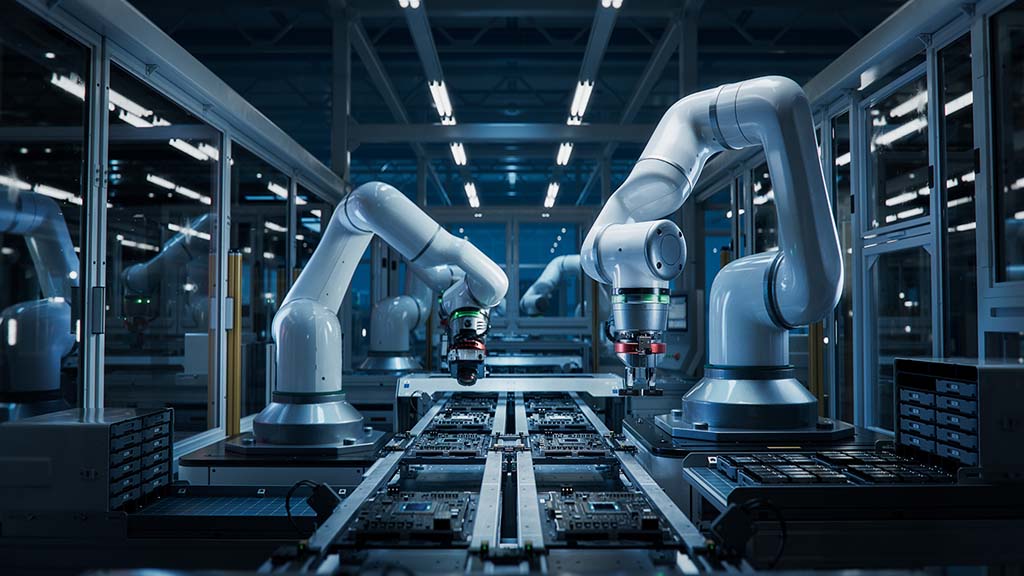Summary:
- AI is transforming industrial automation by enabling systems to learn, adapt, and optimize in real time.
- Predictive maintenance helps detect issues early, reducing downtime and extending equipment life.
- AI improves quality control with advanced defect detection and machine vision capabilities.
- Autonomous systems and robotics are taking on more dynamic roles with minimal human input.
- Manufacturers that build flexible, data-driven infrastructure now are better positioned for future AI integration.
AI in industrial automation is making waves across manufacturing and production floors. What once relied on rigid systems and fixed rules is now becoming smarter, faster, and more flexible. As artificial intelligence continues to evolve, it’s starting to play a bigger role in how businesses manage machines, processes, and data.
So, what does that really look like in practice? From smarter maintenance to autonomous decision-making, AI is opening new doors in automation. In this post, we’ll explore the main ways artificial intelligence is changing the game and why it matters for today’s industrial operations.
The Convergence of AI and Industrial Automation
With the rise of AI, today’s automation systems are gaining the ability to analyze, predict, and adjust in real time. This shift is creating new opportunities to improve everything from production workflows to system reliability.
Why This Matters
AI is especially good at making sense of large amounts of data. When combined with industrial automation, it can help systems make faster decisions, adjust to changes, and improve processes with less human input. This leads to greater efficiency and flexibility in production environments.
Laying the Groundwork with Data
For AI to work well in industrial settings, it needs access to reliable, real-time data. That’s where platforms like Open Automation Software come in. By connecting equipment, sensors, and systems, OAS helps create the kind of data-rich environment AI depends on.
A Smarter Approach to Automation
AI in industrial automation isn’t about starting over. It’s about building on what already works and taking it further. With the right tools and data in place, AI can help make automation systems more responsive, more efficient, and better prepared for whatever comes next.
Predictive Maintenance and Asset Health Monitoring
One of the most practical applications of artificial intelligence in industrial automation is predictive maintenance.
Instead of relying on fixed service schedules or waiting for equipment to fail, AI can analyze real-time data to identify early warning signs. This helps operators address issues before they lead to downtime or costly repairs.

How It Works
AI tools process data from sensors, machines, and control systems to spot unusual patterns or performance shifts. These insights can reveal problems like bearing wear, pressure imbalances, or overheating before they cause a breakdown.
By catching these issues early, businesses can keep operations running more smoothly and avoid unnecessary interruptions.
Why It Matters for Industrial Automation
In the context of AI automation in manufacturing, predictive maintenance improves equipment life, enhances safety, and reduces unplanned downtime. It also helps teams focus their efforts on the assets that actually need attention instead of spreading resources thin with routine checks.
Quality Control and Defect Detection
Quality control is a critical part of any manufacturing process. With the help of AI, manufacturers are improving how they detect defects, maintain consistency, and reduce waste. AI doesn’t just speed things up; it helps catch issues that human inspectors or traditional systems might miss.
AI-Powered Visual Inspection
Machine vision combined with artificial intelligence can quickly analyze products as they move through production. AI models can learn to spot defects in shape, color, texture, or assembly with a high level of accuracy. These systems continuously improve over time, making them more reliable with each batch of data, especially when aligned with ISA automation standards.
Fewer Mistakes, Better Products
Faster and more accurate defect detection means fewer product recalls and better customer satisfaction. It also helps cut costs by reducing the amount of material lost to mistakes or inconsistencies.
For industries like electronics, automotive, and packaging, these improvements have a major impact.
To get consistent performance from AI systems, quality inspection tools need access to clean, real-time production data. Open Automation Software supports this need by delivering flexible data connectivity across machines, PLCs, and industrial systems. That kind of access helps AI models perform at their best without adding complexity to the workflow.
Autonomous Systems and Robotics
Autonomous systems are changing how industrial environments operate. These technologies go beyond automation by giving machines the ability to make decisions and take action without constant human oversight.
In many cases, robots and autonomous equipment can adapt to changing conditions, reroute workflows, and manage tasks with minimal intervention.
From Routine Tasks to Dynamic Roles
While robots have long handled repetitive tasks like welding or assembly, newer systems can now respond to real-time data and environmental feedback.
For example, an autonomous mobile robot might reroute itself to avoid congestion or switch tasks based on production demands. These capabilities make factories more agile and better equipped to handle variability.
Integration and Coordination
Autonomous systems often rely on tight integration between hardware, software, and control platforms. Communication between robots, sensors, and supervisory systems needs to be fast, secure, and reliable. That’s where a strong data infrastructure becomes essential.
With tools that support real-time connectivity and cross-platform integration, companies can keep all systems in sync without overcomplicating operations.
Future Outlook
Artificial intelligence is still gaining ground in the industrial space, and its potential is far from fully realized. As AI models become faster and more efficient, they will unlock even more ways to optimize operations, reduce costs, and improve system flexibility.
Edge computing is expected to play a growing role as well, allowing AI to process data directly at the source rather than relying on cloud-only solutions. This will help manufacturers respond even faster to real-time conditions while reducing network strain.
We’ll also see more collaboration between humans and machines. Instead of replacing jobs, AI and robotics will continue to support workers by handling routine tasks, surfacing insights, and improving safety across industrial environments.
For businesses exploring what’s next, now is a great time to see these capabilities in action.
Request a free, interactive demo with Open Automation Software and get all your questions answered by our team of experts.
